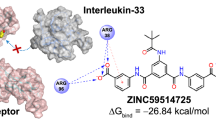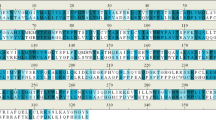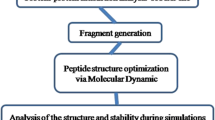Abstract
In this study the three-dimensional (3-D) model of the ligand-binding domain (V106-P322) of human interleukin-6 receptor (hIL-6 R) was constructed by computer-guided homology modeling technique using the crystal structure of the ligand-binding domain (K52-L251) of human growth hormone receptor (hGHR) as templet. Furthermore, the active binding region of the 3-D model of hIL-6R with the ligand (hIL-6) was predicted. In light of the structural characteristics of the active region, a hydrophobic pocket shielded by two hydrophilic residues (E115 and E505) of the region was identified by a combination of molecular modelling and the site-directed or double-site mutation of the twelve crucial residues in the ligand-binding domain of hIL-6R (V106-P322). We observed and analyzed the effects of these mutants on the spatial conformation of the pocket-like region of hIL-6 R. The results indicated that any site-directed mutation of the five Cys residues (four conservative Cys residues: Cys121, Cys132, Cys165, Cys176; near membrane Cys residue: Cys193) or each double-site mutation of the five residues in WSEWS motif of hIL-6R (V106-P322) makes the corresponding spatial conformation of the pocket region block the linkage between hIL-6 R and hIL-6. However, the influence of the site-directed mutation of Cys211 and Cys277 individually on the conformation of the pocket region benefits the interaction between hIL-6R and hIL-6. Our study suggests that the predicted hydrophobic pocket in the 3-D model of hIL-6R (V106-P322) is the critical molecular basis for the binding of hIL-6R with its ligand, and the active pocket may be used as a target for designing small hIL-6R-inhibiting molecules in our further study.
Similar content being viewed by others
References
Li, S., Satoh, T., Korngold, R. et al., Proposed CD4 dimerization sites indicate a novel mode of co-oligomerization of CD4, MHC class II, and TCR molecules, Immunol. Today, 1998, 19(10): 455.
Li, S., Gao, J., Satoh, T. et al., A computer screening approach to immunoglobulin superfamily structures and interactions: Discovery of small non-peptidic CD4 inhibitors as novel immunotherapeutics, Proc. Nat. Acad. Sci. USA, 1997, 94(1): 73.
Satoh, T., Aramini, J.M., Li, S. et al., Bioactive peptide design based on protein surface epitopes: a cyclic heptapeptide mimics CD4 domain 1 CC′ loop and inhibits CD4 biological function, J. Biol. Chem., 1997, 272: 12175.
Simpson, R.J., Hammacher, A., Smith, D.K. et al., Interleukin-6: structure-function relationships, Protein Sci., 1997, 6(5): 929.
Papadaki, H., Kyriakou, D., Foudoulakis, A. et al., Serum levels of soluble IL-6 receptor in multiple myeloma as indicator of disease activity, Acta Haematol., 1997, 97(4): 191.
Yamamura, M., Yamada, Y., Momita, S. et al., Circulating interleukin-6 levels are elevated in adult T-cell leukaemia/lymphoma patients and correlate with adverse clinical features and Survival, Br. J. Haematol., 1998, 100(1): 129.
Somers, W., Stahl, M., Seehra, J.S., 1.9 A crystal structure of interleukin 6: implications for a novel mode of receptor dimerization and signaling, EMBO J., 1997, 16(5): 989.
Yawata, H., Yasukawa, K., Shunji, N. et al., Structure-function analysis of human IL-6 receptor: dissociation of amino acid residues reguied for IL-6-binding and IL-6 signal transduction through gp130, EMBO J., 1993, 12: 1705.
Duan, J. B., Wang, J. X., Cai, X. et al., Characterization of a soluble IL-6 receptor a mutant C277D/H280I expressed inE. coli, Biochemistry and Molecular Biology International, 1997, 41(6): 1101.
Ren, Y. F., Qu, H., Feng, J. N. et al., Prediction of the active region in the extracellular ligand-binding domain of human interleukin-6 receptor, Chinese Science Bulletin, 2000, 45(3): 301.
Ren, Y. F., Guo, N., Zhang, H. Q. et al., Introduction and expression of the recombinant human IL-6 receptor gene in rat myelocytic leukaemia cells, Journal of Experimental Hematology (in Chinese), 1994, 2(1): 35.
Kruttgen, A., Rose-John, S., Dufhues, G. et al., The three carboxy-terminal amino acids of human interleukin-6 are essential for its biological activity, FEBS Lett., 1990, 273: 95.
Lutticken, C., Kruttgen, A., Moller, C. et al., Evidence for the importance of a positive charge and an α-helical structure of the C-terminus for biological activity of human IL-6, FEBS Lett., 1991, 282: 265.
Leebeek, F. W. G., Kariya, K., Sehwabe, M. et al., Identification of a receptor binding site in the carboxyl terminus of human interleukin-6, J. B. C., 1992, 267: 14832.
Stoddard, B. L., Koshland, D. E., Prediction of the structure of a receptor-protein complex using a binary docking method, Nature, 1992, 358: 774.
Author information
Authors and Affiliations
Corresponding author
Rights and permissions
About this article
Cite this article
Ren, Y., Feng, J., Qu, H. et al. Three-dimensional structure and function study on the active region in the extracellular ligand-binding domain of human IL-6 receptor. Sci. China Ser. C.-Life Sci. 43, 425–432 (2000). https://doi.org/10.1007/BF02879308
Received:
Issue Date:
DOI: https://doi.org/10.1007/BF02879308




